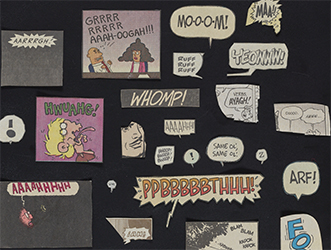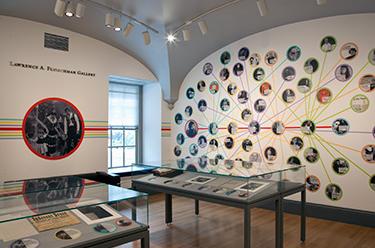Get Involved
Internship, fellowship, and volunteer opportunities provide students and lifelong learners with the ability to contribute to the study and preservation of visual arts records in America.
Past Exhibitions
Revisit almost twenty years of the Archives’ past exhibitions covering various topics, projects, and events in art history.
This digital project is organized by the Smithsonian American Art Museum with the Smithsonian's Archives of American Art as a companion to the exhibition Subversive, Skilled, Sublime: Fiber Art by Women. Support for this digital project has been provided by the Smithsonian American Women’s History Initiative.
This exhibition provides some fascinating and helpful starting points by introducing staff members and items they find special, sometimes for very personal reasons. Welcome to the Archives of American Art!
Organized by Curator of Manuscripts Mary Savig, the exhibition revisits a 1977 exhibition at Los Angeles’ Woman’s Building, a feminist art school, gallery, and community space founded by Judy Chicago, Sheila Levrant de Bretteville, and Arlene Raven in 1971. The Archives, which holds the Woman’s Building papers in its collections, will reconsider this exhibition by showing responses from the 1977 show alongside new submissions by both original participating artists as well as a new generation of diverse artists. Approximately 75 works will be on view.
This exhibition was organized by the Archives of American Art in collaboration with Smithsonian Gardens. The labels were written by archivists, horticulturalists, artists, curators, educators, and gardeners to articulate the many facets of flora. The various perspectives highlight the cross-pollination of ideas between the natural world and American art history, and more broadly, the generative intersection of art and science. All documents on view are from collections in the Archives of American Art.
Mail art (alternatively called “correspondence art” or “postal art”) emerged as a form of artistic practice in which an international network of participants use the mail to make art and share it with others regarding culture and communications, creatively sidestepping the art market and, in many instances, eluding government censors.

Join us on a road trip through the Archives of American Art. The photographs, sketches, diaries, correspondence, and video recordings on view reveal how artists have shaped and are shaped by their surroundings, from the 1830s to the 2000s. These materials lead us off the beaten track, offering unexpected insight into local and regional histories as well as personal stories of exploration, immigration, and migration. Together, documents from all 50 states and the District of Columbia represent the diversity and depth of art in the United States.

Alternatively expressive and aloof, the contradictory attitudes of cats make them compelling sources of inspiration. They are seen in numerous guises: playful subjects, humorous topics of conversation, independent studio companions, and beloved members of the family.

In celebration of the 2016 Grand Opening of the National Museum of African American History and Culture at the Smithsonian Institution, the Archives of American Art presents selections from recently acquired collections, highlighting the cultural contributions and the personal stories of African Americans in the art world.

Artists find inspiration everywhere. Even the most ordinary circumstances can prompt new ways of thinking about and making art. The artists featured in this exhibition collected, organized, and transformed a wide variety of source materials as part of their creative process: comic strip panels, newspaper clippings, snapshots of mundane scenes. Yet the ways in which artists draw on them provides a glimpse into the twists and turns of their creative practices.

Robert Motherwell (1915–1991) helped forge a new vision of painting that established Abstract Expressionism at the vanguard of post-war painting and transformed New York into the epicenter of the art world in the second half of the twentieth century.

n this era of digital communication, contacts can be quickly updated, shared, and even deleted at the click of a button. Before smartphones and computers, traditional address books stored important, and sometimes confidential, contact information and other details. The grimy, dog-eared pages of these pocket-sized books reveal webs of personal and professional connections. Often, the depth of each relationship remains a mystery—a name jotted down in tangled ink and pencil might be a close friend, a family member, a recent acquaintance, or a critic.

Included in this exhibition are letters, photographs, writings, and rare printed materials documenting Yasuo Kuniyoshi’s life and work. This exhibition was organized in conjunction with “The Artistic Journey of Yasuo Kuniyoshi” exhibition at the Smithsonian American Art Museum.



The Smithsonian’s Archives of American Art holds in its collections hundreds of handmade holiday cards. The cards featured in this exhibition reveal how artists imagined the holidays through whimsical watercolors, quirky collages, and cheerful prints and drawings.
Internship, fellowship, and volunteer opportunities provide students and lifelong learners with the ability to contribute to the study and preservation of visual arts records in America.
Read the full chronology of exhibitions organized by the Archives of American Art.

The Archives of American Art’s exhibition space is located two blocks away from our D.C. Research Center in the Donald W. Reynolds Center for American Art and Portraiture (8th and F Streets NW).
Please visit www.si.edu/visit for more information and to review safety requirements before your visit.
Learn more about visiting the gallery.
Hours: Open daily 11:30 a.m.–7:00 p.m.
Admission: Free